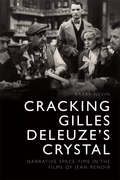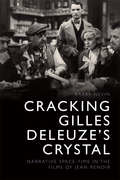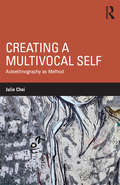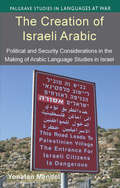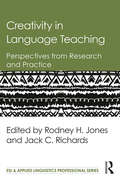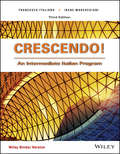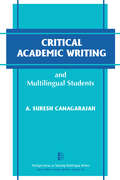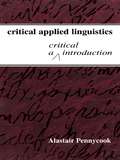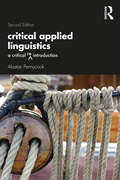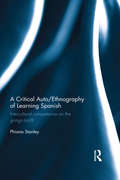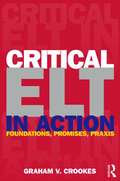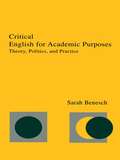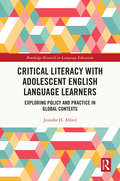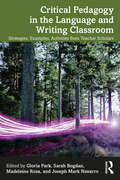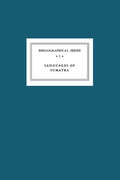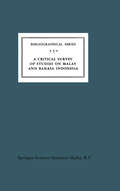- Table View
- List View
Cracking Gilles Deleuze's Crystal: Narrative Space-time in the Films of Jean Renoir
by Barry NevinThe first collection of critical essays on the writing of Kathleen Jamie
Cracking Gilles Deleuze's Crystal: Narrative Space-time in the Films of Jean Renoir
by Barry NevinExplores the dynamic relationships between language, politics and society in the Middle East
Creating a Multivocal Self: Autoethnography as Method
by Julie ChoiShowcasing a new methodology in language learning and identity research, this carefully conceptualized, innovative book explicates the use of autoethnography as a way of re-imagining one’s sense of linguistic and cultural identity. A key work for researchers and students in Applied Linguistics and Language Education, it addresses fundamental aspects of research methodology and explores substantive issues relating to individual dimensions of multilingualism. Choi shows convincingly how the learning of a language is inseparable from one’s constant searching for a voice, a place, and a self in this world, demonstrating the importance of interrogating what lies behind everyday life events and interactions—the political and ethical implications of the utterances, thoughts, actions, and stories of the self and others. Themes of authenticity, illegitimacy, power relations, perceptions of self/other, cultural discourses and practices, and related issues in multilingual identity development surface in the multi-modal narratives. Chapters on methodology, woven through the book, focus on the process of knowledge production, approaches to writing narratives, the messiness of research writing practices, and the inseparability of writing and research.
Creating a Multivocal Self: Autoethnography as Method
by Julie ChoiShowcasing a new methodology in language learning and identity research, this carefully conceptualized, innovative book explicates the use of autoethnography as a way of re-imagining one’s sense of linguistic and cultural identity. A key work for researchers and students in Applied Linguistics and Language Education, it addresses fundamental aspects of research methodology and explores substantive issues relating to individual dimensions of multilingualism. Choi shows convincingly how the learning of a language is inseparable from one’s constant searching for a voice, a place, and a self in this world, demonstrating the importance of interrogating what lies behind everyday life events and interactions—the political and ethical implications of the utterances, thoughts, actions, and stories of the self and others. Themes of authenticity, illegitimacy, power relations, perceptions of self/other, cultural discourses and practices, and related issues in multilingual identity development surface in the multi-modal narratives. Chapters on methodology, woven through the book, focus on the process of knowledge production, approaches to writing narratives, the messiness of research writing practices, and the inseparability of writing and research.
The Creation of Israeli Arabic: Security and Politics in Arabic Studies in Israel (Palgrave Studies in Languages at War)
by Y. MendelThis book sheds light on the ways in which the on-going Israeli-Arab conflict has shaped Arabic language instruction. Due to its interdisciplinary nature it will be of great interest to academics and researchers in security and middle eastern studies as well as those focused on language and linguistics.
Creativity in Language Teaching: Perspectives from Research and Practice (ESL & Applied Linguistics Professional Series)
by Jack C. Richards Rodney H. JonesCurrent, comprehensive, and authoritative, this text gives language teachers and researchers, both a set of conceptual tools with which to think and talk about creativity in language teaching and a wealth of practical advice about principles and practices that can be applied to making their lessons more creative. Providing an overview of the nature of creativity and its role in second language education, it brings together twenty prominent language teachers and researchers with expertise in different aspects of creativity and teaching contexts to present a range of theories on both creative processes and how these processes lead to creative practices in language teaching. Unique in the field, the book takes a broader and more critical look at the notion of creativity in language learning, exploring its linguistic, cognitive, sociocultural and pedagogic dimensions. Structured in four sections— theoretical perspectives, creativity in the classroom, creativity in the curriculum, and creativity in teacher development—each chapter is supplemented by Questions for Discussion and Suggestions for Further Research. Its accessible style makes the book relevant as both a course text and a resource for practicing teachers.
Creativity in Language Teaching: Perspectives from Research and Practice (ESL & Applied Linguistics Professional Series)
by Jack C. Richards Rodney H. JonesCurrent, comprehensive, and authoritative, this text gives language teachers and researchers, both a set of conceptual tools with which to think and talk about creativity in language teaching and a wealth of practical advice about principles and practices that can be applied to making their lessons more creative. Providing an overview of the nature of creativity and its role in second language education, it brings together twenty prominent language teachers and researchers with expertise in different aspects of creativity and teaching contexts to present a range of theories on both creative processes and how these processes lead to creative practices in language teaching. Unique in the field, the book takes a broader and more critical look at the notion of creativity in language learning, exploring its linguistic, cognitive, sociocultural and pedagogic dimensions. Structured in four sections— theoretical perspectives, creativity in the classroom, creativity in the curriculum, and creativity in teacher development—each chapter is supplemented by Questions for Discussion and Suggestions for Further Research. Its accessible style makes the book relevant as both a course text and a resource for practicing teachers.
Crescendo!: An Intermediate Italian Program
by Francesca Italiano Irene MarchegianiCrescendo!, 3rd Edition is a comprehensive intermediate Italian program designed to build proficiency in all four language skills (listening, reading, speaking, and writing), and to expand students cultural knowledge of contemporary Italy. The Crescendo! program helps build a dynamic and interactive environment by providing opportunities for practice through a systematic and spiral presentation of themes and current issues that are both relevant and interesting, and by encouraging readers to express themselves freely and creatively in a wide spectrum of contexts.
Critical Academic Writing and Multilingual Students: Critical Academic Writing And Multilingual Students (The Michigan Series on Teaching Multilingual Writers)
by Attelstan Suresh CanagarajahThe critical approach to L2 writing is arguably one of the most significant recent developments in L2 writing pedagogy. A. Suresh Canagarajah provides a thorough discussion of this topic in Critical Academic Writing and Multilingual Students. This volume facilitates teacher self-reflection and enables readers to better understand the motivations and pedagogical implications--especially for L2 writing--of a more openly pedagogical approach. Critical Academic Writing and Multilingual Students explains what it means to commit to an academic pedagogy, in terms of form, self, content, and community--and what it can accomplish in the L2 writing classroom. It's a guide for writing teachers who wish to embark on a journey toward increased critical awareness of the role they play, or potentially could play, in the lives of their students.
Critical Applied Linguistics: A Critical Introduction
by Alastair PennycookThis accessible guide and introduction to critical applied linguistics provides a clear overview, highlighting problems, debates, and competing views in language education, literacy, discourse analysis, language in the workplace, translation and other language-related domains. Covering both critical theory and domains of practice, the book is organized around five themes: the politics of knowledge, the politics of language, the politics of texts, the politics of pedagogy, and the politics of difference. It is an important text for anyone involved in applied linguistics, TESOL, language education, or other language-related fields.
Critical Applied Linguistics: A Critical Introduction
by Alastair PennycookThis accessible guide and introduction to critical applied linguistics provides a clear overview, highlighting problems, debates, and competing views in language education, literacy, discourse analysis, language in the workplace, translation and other language-related domains. Covering both critical theory and domains of practice, the book is organized around five themes: the politics of knowledge, the politics of language, the politics of texts, the politics of pedagogy, and the politics of difference. It is an important text for anyone involved in applied linguistics, TESOL, language education, or other language-related fields.
Critical Applied Linguistics: A Critical Re-Introduction
by Alastair PennycookNow in its second edition, this accessible guide and introduction to critical applied linguistics provides a clear overview of the problems, debates, and competing views in language education, literacy, discourse analysis, language in the workplace, translation, and other language-related domains. Covering both critical theory and domains of practice, the book is organized around five themes: the politics of knowledge, the politics of language, the politics of difference, the politics of texts, and the politics of pedagogy. Recognizing that a changing world requires new ways of thinking, and that many approaches have watered down over time, the new edition applies a sharp, fresh look at established and new intellectual frameworks. The second edition is comprehensively updated with additional research throughout and features new discussions of colonialism, queer theory, race and gender, translanguaging, and posthumanism. With a critical focus on the role of applied linguists, Pennycook emphasizes the importance of a situated, collaborative perspective that takes the discussion away from questions of implementation, and insists instead that critical applied linguistics has to be an emergent program from the contexts in which it works. This landmark text is essential reading for students and researchers of applied linguistics, multilingualism, language and education, TESOL, and language and identity.
Critical Applied Linguistics: A Critical Re-Introduction
by Alastair PennycookNow in its second edition, this accessible guide and introduction to critical applied linguistics provides a clear overview of the problems, debates, and competing views in language education, literacy, discourse analysis, language in the workplace, translation, and other language-related domains. Covering both critical theory and domains of practice, the book is organized around five themes: the politics of knowledge, the politics of language, the politics of difference, the politics of texts, and the politics of pedagogy. Recognizing that a changing world requires new ways of thinking, and that many approaches have watered down over time, the new edition applies a sharp, fresh look at established and new intellectual frameworks. The second edition is comprehensively updated with additional research throughout and features new discussions of colonialism, queer theory, race and gender, translanguaging, and posthumanism. With a critical focus on the role of applied linguists, Pennycook emphasizes the importance of a situated, collaborative perspective that takes the discussion away from questions of implementation, and insists instead that critical applied linguistics has to be an emergent program from the contexts in which it works. This landmark text is essential reading for students and researchers of applied linguistics, multilingualism, language and education, TESOL, and language and identity.
A Critical Auto/Ethnography of Learning Spanish: Intercultural competence on the gringo trail?
by Phiona StanleyThe premise that intercultural contact produces intercultural competence underpins much rationalization of backpacker tourism and in-country language education. However, if insufficiently problematized, pre-existing constructions of cultural 'otherness' may hinder intercultural competence development. This is nowhere truer than in contexts in which wide disparities of power, wealth, and privilege exist, and where such positionings may go unproblematized. This study contributes to theoretical understandings of how intercultural competence develops through intercultural contact situations through a detailed, multiple case study of three conceptually comparable contexts in which Western backpackers study Spanish in Latin America. This experience, often 'bundled' with home-stay, volunteer work, social, and tourist experiences, offers a rich set of empirical data within which to understand the nature of intercultural competence and the processes through which it may be developed. Models of a single, context-free, transferable intercultural competence are rejected. Instead, suggestions are made as to how educators might help prepare intercultural sojourners by scaffolding their intercultural reflections and problematizing their own intersectional identities and their assumptions. The study is a critical ethnography with elements of autoethnographic reflection. The book therefore also contributes to development of this qualitative research methodology and provides an empirical example of its application.
A Critical Auto/Ethnography of Learning Spanish: Intercultural competence on the gringo trail?
by Phiona StanleyThe premise that intercultural contact produces intercultural competence underpins much rationalization of backpacker tourism and in-country language education. However, if insufficiently problematized, pre-existing constructions of cultural 'otherness' may hinder intercultural competence development. This is nowhere truer than in contexts in which wide disparities of power, wealth, and privilege exist, and where such positionings may go unproblematized. This study contributes to theoretical understandings of how intercultural competence develops through intercultural contact situations through a detailed, multiple case study of three conceptually comparable contexts in which Western backpackers study Spanish in Latin America. This experience, often 'bundled' with home-stay, volunteer work, social, and tourist experiences, offers a rich set of empirical data within which to understand the nature of intercultural competence and the processes through which it may be developed. Models of a single, context-free, transferable intercultural competence are rejected. Instead, suggestions are made as to how educators might help prepare intercultural sojourners by scaffolding their intercultural reflections and problematizing their own intersectional identities and their assumptions. The study is a critical ethnography with elements of autoethnographic reflection. The book therefore also contributes to development of this qualitative research methodology and provides an empirical example of its application.
Critical ELT in Action: Foundations, Promises, Praxis
by Graham V. CrookesUniquely bridging theory and practice, this text introduces and overviews the various domains associated with the term critical pedagogy in the field of TESOL/ELT. Critical pedagogy addresses concepts, values, curriculum, instructional and associated practices involved in language teaching for social justice. Bringing critical pedagogy to classroom practitioners in a practical and comprehensible way, the text is designed to help teachers get started on critically grounded work in their own teaching. Features• Textbook extracts offer direct and quick illustration of what this perspective might look like in practice• Coverage of feminist and anti-racist pedagogies; sexual identity, oppression and pedagogy; peace and environmental education; and critical English as a foreign language—and their implications for second-language teaching • Historical background• Theoretical background on language and learning• Consideration of applicability of critical/radical educational concepts and traditions to non-Western cultural contexts • A focus on issues of compromise and resistance This original, timely, and informative text is ideal for any course on methods and approaches in TESOL.
Critical ELT in Action: Foundations, Promises, Praxis
by Graham V. CrookesUniquely bridging theory and practice, this text introduces and overviews the various domains associated with the term critical pedagogy in the field of TESOL/ELT. Critical pedagogy addresses concepts, values, curriculum, instructional and associated practices involved in language teaching for social justice. Bringing critical pedagogy to classroom practitioners in a practical and comprehensible way, the text is designed to help teachers get started on critically grounded work in their own teaching. Features• Textbook extracts offer direct and quick illustration of what this perspective might look like in practice• Coverage of feminist and anti-racist pedagogies; sexual identity, oppression and pedagogy; peace and environmental education; and critical English as a foreign language—and their implications for second-language teaching • Historical background• Theoretical background on language and learning• Consideration of applicability of critical/radical educational concepts and traditions to non-Western cultural contexts • A focus on issues of compromise and resistance This original, timely, and informative text is ideal for any course on methods and approaches in TESOL.
Critical English for Academic Purposes: Theory, Politics, and Practice
by Sarah BeneschCritical English for Academic Purposes: Theory, Politics, and Practice is the first book to combine the theory and practice of two fields: English for academic purposes and critical pedagogy. English for academic purposes (EAP) grounds English language teaching in the cognitive and linguistic demands of academic situations, tailoring instruction to specific rather than general purposes. Critical pedagogy acknowledges students' and teachers' subject-positions, that is, their class, race, gender, and ethnicity, and encourages them to question the status quo. Critical English for academic purposes engages students in the types of activities they are asked to carry out in academic classes while inviting them to question and, in some cases, transform those activities, as well as the conditions from which they arose. It takes into account the real challenges non-native speakers of English face in their discipline-specific classes while viewing students as active participants who can help shape academic goals and assignments. Critical English for Academic Purposes: Theory, Politics, and Practice: * relates English for academic purposes and critical pedagogy, revealing and problematizing the assumptions of both fields, * provides theoretical and practical responses to academic syllabi and other institutional demands to show that teachers can both meet target demands and take students' subjectivities into account in a climate of negotiation and possibility, * offers "rights analysis" as a critical counterpart to needs analysis, * discusses the politics of "coverage" in lecture classes and proposes alternatives, and * features teaching examples that address balancing the curriculum for gender; building community in an EAP class of students from diverse economic and social backgrounds; students' rights; and organizing students to change unfavorable conditions. This book is intended for undergraduate and graduate courses for preservice and in-service ESL and EAP teachers. It is also a professional book for those interested in critical approaches to teaching and EAP.
Critical English for Academic Purposes: Theory, Politics, and Practice
by Sarah BeneschCritical English for Academic Purposes: Theory, Politics, and Practice is the first book to combine the theory and practice of two fields: English for academic purposes and critical pedagogy. English for academic purposes (EAP) grounds English language teaching in the cognitive and linguistic demands of academic situations, tailoring instruction to specific rather than general purposes. Critical pedagogy acknowledges students' and teachers' subject-positions, that is, their class, race, gender, and ethnicity, and encourages them to question the status quo. Critical English for academic purposes engages students in the types of activities they are asked to carry out in academic classes while inviting them to question and, in some cases, transform those activities, as well as the conditions from which they arose. It takes into account the real challenges non-native speakers of English face in their discipline-specific classes while viewing students as active participants who can help shape academic goals and assignments. Critical English for Academic Purposes: Theory, Politics, and Practice: * relates English for academic purposes and critical pedagogy, revealing and problematizing the assumptions of both fields, * provides theoretical and practical responses to academic syllabi and other institutional demands to show that teachers can both meet target demands and take students' subjectivities into account in a climate of negotiation and possibility, * offers "rights analysis" as a critical counterpart to needs analysis, * discusses the politics of "coverage" in lecture classes and proposes alternatives, and * features teaching examples that address balancing the curriculum for gender; building community in an EAP class of students from diverse economic and social backgrounds; students' rights; and organizing students to change unfavorable conditions. This book is intended for undergraduate and graduate courses for preservice and in-service ESL and EAP teachers. It is also a professional book for those interested in critical approaches to teaching and EAP.
Critical Literacy with Adolescent English Language Learners: Exploring Policy and Practice in Global Contexts (Routledge Research in Language Education)
by Jennifer AlfordThis book examines critical literacy within language and literacy learning, with a particular focus on English as an Additional Language learners in schools who traditionally are not given the same exposure to critical literacy as native-English speakers. An important and innovative addition to extant literature, this book explains how English language teachers understand critical literacy and enact it in classrooms with adolescent English language learners from highly diverse language backgrounds. This book brings together the study of two intersecting phenomena: how critical literacy is constructed in English language education policy for adolescent English language learners internationally and how critical literacy is understood and enacted by teachers amid the so-called ‘literacy crisis’ in neoliberal eduscapes. The work traces the ways critical literacy has been represented in English language education policy for adolescents in five contexts: Australia, England, Sweden, Canada and the United States. Drawing on case study research, it provides a comparative analysis of how policy in these countries constructs critical literacy, and how this then positions critical engagement as a focus for teachers of English language learners. Empirically based and accessibly written, this timely book will be of interest to a wide range of academics in the fields of adolescent literacy education, English language learning and teaching, education policy analysis, and critical discourse studies. It will also appeal to teachers, post-graduate students and language education policy makers.
Critical Literacy with Adolescent English Language Learners: Exploring Policy and Practice in Global Contexts (Routledge Research in Language Education)
by Jennifer AlfordThis book examines critical literacy within language and literacy learning, with a particular focus on English as an Additional Language learners in schools who traditionally are not given the same exposure to critical literacy as native-English speakers. An important and innovative addition to extant literature, this book explains how English language teachers understand critical literacy and enact it in classrooms with adolescent English language learners from highly diverse language backgrounds. This book brings together the study of two intersecting phenomena: how critical literacy is constructed in English language education policy for adolescent English language learners internationally and how critical literacy is understood and enacted by teachers amid the so-called ‘literacy crisis’ in neoliberal eduscapes. The work traces the ways critical literacy has been represented in English language education policy for adolescents in five contexts: Australia, England, Sweden, Canada and the United States. Drawing on case study research, it provides a comparative analysis of how policy in these countries constructs critical literacy, and how this then positions critical engagement as a focus for teachers of English language learners. Empirically based and accessibly written, this timely book will be of interest to a wide range of academics in the fields of adolescent literacy education, English language learning and teaching, education policy analysis, and critical discourse studies. It will also appeal to teachers, post-graduate students and language education policy makers.
Critical Pedagogy in the Language and Writing Classroom: Strategies, Examples, Activities from Teacher Scholars
by Gloria Park Sarah Bogdan Madeleine Rosa Joseph Mark NavarroThis volume introduces theory-to-practice-based critical pedagogy grounded in Paulo Freire’s scholarship to language and literacy learning settings. The chapters present authentic experiences of teacher-scholars, feature real-world examples and activities ready for implementation in the classroom, and provide nuanced guidance for future teachers. The examples and activities from teacher-scholars place critical pedagogy at the heart of classroom contexts and cover key topics, including place-based pedagogy, contemplative pedagogy, technology within the classroom, and translingual and multimodal paradigms. The chapters include further readings and discussion questions that challenge assumptions and promote deeper reflection, and can be modified for different teaching contexts. This practical volume is essential reading for students and scholars in TESOL and critical pedagogy.
Critical Pedagogy in the Language and Writing Classroom: Strategies, Examples, Activities from Teacher Scholars
by Gloria Park Sarah Bogdan Madeleine Rosa Joseph Mark NavarroThis volume introduces theory-to-practice-based critical pedagogy grounded in Paulo Freire’s scholarship to language and literacy learning settings. The chapters present authentic experiences of teacher-scholars, feature real-world examples and activities ready for implementation in the classroom, and provide nuanced guidance for future teachers. The examples and activities from teacher-scholars place critical pedagogy at the heart of classroom contexts and cover key topics, including place-based pedagogy, contemplative pedagogy, technology within the classroom, and translingual and multimodal paradigms. The chapters include further readings and discussion questions that challenge assumptions and promote deeper reflection, and can be modified for different teaching contexts. This practical volume is essential reading for students and scholars in TESOL and critical pedagogy.
Critical Survey Of Studies On The Languages of Sumatra (Koninklijk Instituut voor Taal-, Land- en Volkenkunde)
by P. VoorhoeveThe aim of the critical bibliographies, compiled on the initiative of the Board of Directors of the Royal Institute of Linguistics, Geography and Ethnology, is to draw attention to the data on Indonesian lin~ guistics and cultural sciences collected in the past, and to provide guidance in this field. It so happens that these data were often published in journals with a limited circulation, whilst these journals are only available in a few places. Moreover, most of them are only accessible without difficulty to those workers in the fields of Indonesian linguistics and cultural sciences who possess some knowledge of the Dutch language. Apart from providing information, these bibliographies also have an other object, viz. to prevent that meritorious scholarly work would be lost due to the purely fortuitous circumstance - which, however, in actual practice is unfortunately of decisive importance - that this work is not written in a world language and that it cannot be every where easily consulted. The Board therefore hope at the same time to break with the slightly provincialistic nature which for evident reasons used to be characteristic for the studies in language and culture of Indonesia. The Board hope to be able to prevent that new research should have to start unnecessarily again at the very beginning, and also to contribute to a more rapid progress of scientific research in this field by means of a regular publication of these critical reviews of pubIications.
A Critical Survey of Studies on Malay and Bahasa Indonesia: Bibliographical Series 5 (Koninklijk Instituut voor Taal-, Land- en Volkenkunde #5)
by A. TeeuwIn this book I have aimed at completeness in the sense that all publications known to me, which are wholly or partly devoted to Malay and Bahasa Indonesia (B.I.), or are important for the study of these languages, have been included. Popular publications in non-professional periodicals have been included only exceptionally. All the publications mentioned in the text are incorporated in the Bibliography (p. 91-157). The countless articles in four post-war, semi-professional periodicals in :'1alaya and Indonesia, Dewan Bahasa, Pembina Bahasa Indonesia. 11:1 edan Bahasa, Bahasa dan Budaja, are not mentioned separately in the Bibliography, but sections 33 to 36 contain a survey, as complete and systematic as possible, of the contents of these periodicals in so far as they pertain to the Malay language; nor have I discussed in the text or incorporated in the Bibliography several hundreds of titles of practical textbooks or school-books of Malay or B.I. which are of no importance to the scientific study of these language. These titles have been entered in a separate Appendix (p. 158--171). The fact that completeness was aimed at certainly does not mean that it has been achieved. Especially various recent writings from Indonesia and Malaya may have escaped my attention. Experience has also proved that publications on Malay sometimes appear in the most unexpected places. The qualification above: "publications ... devoted to ... , or impor tant for the study of" Malay and B.I. has been taken in a wide sense.
